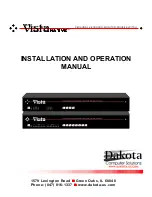
V I S T A I N S T A L L A T I O N A N D O P E R A T I O N MA N U A L
10
Table 4. Typematic rate
Rate
Keys/sec
Rate
Value
Rate
Keys/sec
Rate
Value
Rate
Keys/sec
Rate
Value
Rate
Keys/sec
Rate
Value
30.0
0
15.0
8
7.5
16
3.7
24
26.7
1
13.3
9
6.7
17
3.3
25
24.0
2
12.0
10
6.0
18
3.0
26
21.8
3
10.9
11
5.5
19
2.7
27
20.0
4
10.0
12
5.0
20
2.5
28
18.5
5
9.2
13
4.6
21
2.3
29
17.1
6
8.6
14
4.3
22
2.1
30
16.0
7
8.0
15
4.0
23
2.0
31
Table 5. Typematic delay
Delay in
millisec.
Delay
value
Delay in
millisec.
Delay
value
Delay in
millisec.
Delay
value
Delay in
millisec.
Delay
value
250
0
500
32
750
64
1000
96
Maximum computers command
This command tells the Vista system the total number of computers connected. It is used so that
computer scanning can bypass unused ports on the unit. For example with an eight-port unit if no
computers were connected to ports 7 and 8 you could scan computers 1-6
and bypass 7 and 8.
To
issue the command press and release the
left
Control Key, type
"P"
,
enter the total number of
computers, and press
<Enter>.
Follow with the Keep command to save the new setting in the unit's
non-volatile memory.
PS/2 to serial mouse translation, wheel mouse
You can use some computers with PS/2 mouse interfaces and some computers with serial
interfaces. You must issue this command on each computer, which is serial. You must switch to
each computer and issue the command.
To configure a computer for a serial mouse, press and release the
left
Control Key, type
"Q1"
, and
press
<Enter>.
Follow with the Keep command to save the new setting in the unit's non-volatile
memory. To restore a computer which was previously set to serial to regular PS/2 use Q0 instead of
Q1.
Whether a computer uses a PS/2 wheel mouse or a regular PS/2 mouse is learned by Vista when
the computer loads its mouse driver. This will override any previous setting. You can tell Vista to
change its PS/2 communication to regular or wheel with the Q command. You can also save it to
non-volatile memory.



























